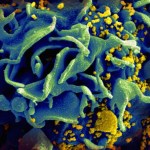OCD
Scientists use a 'gene gun' to insert a gene from a flowering plant called rockcress into the cells of wheat seeds. The genetically modified wheat became more resistant to a fungus called take-all, which in real life can cause "a 40-60% reduction in wheat yields."
T-cells from six HIV+ patients were removed from their bodies, treated with a zinc-finger nuclease designed to snip a gene out of the cell's DNA, and put back in the patients. Removal of the gene mimics a naturally occurring mutation which confers resistance to the HIV virus. But only 25% of the treated cells showed…
Dogs, like people, are susceptible to a form of obsessive compulsive disorder (OCD) known as canine compulsive disorder (CCD). In fact, the news story at the end of this blog describes CCD and also discusses a form of OCD in Siamese and Persian cats that is related to stress.
A prior study suggested that dogs are good models for OCD in humans since their physiology is similar and they share the same environment as humans. Dr. Hannes Lohi (University of Helsinki) and colleagues found that dogs who received vitamin and mineral supplements were less likely to exhibit CCD (measured as excessive…
TRICHOTILLOMANIA (or hair pulling) is a condition characterised by excessive grooming and strong, repeated urges pull out one's own hair. It is classified as an obsessive-compulsive disorder (OCD), and is relatively common, affecting about 2 in 100 people. Sufferers normally feel an increasing sense of tension before pulling out their scalp hair, facial hair, and even pubic hair, eyelashes or eyebrows. This provides gratification, but only briefly.
Hair pulling is usually thought of as being psychological in origin, but an intruiging new study now suggests that it occurs as a result of…
